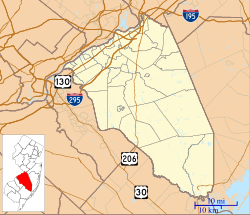Atsion, New Jersey | |
|---|---|
 Samuel Richards Mansion in Atsion | |
| Coordinates: 39°44′33″N74°43′34″W / 39.74250°N 74.72611°W | |
| Country | |
| State | |
| County | Burlington |
| Township | Shamong |
| Elevation | 49 ft (15 m) |
| Time zone | UTC−05:00 (Eastern (EST)) |
| • Summer (DST) | UTC−04:00 (EDT) |
| GNIS feature ID | 874418 [1] |
Atsion is an unincorporated community located within Shamong Township in Burlington County, in the U.S. state of New Jersey. [2] The community is located next to Atsion Lake.
Contents
The settlement is located within the Wharton State Forest, and a forest office, parking area and information kiosk are located at Atsion. [3]



